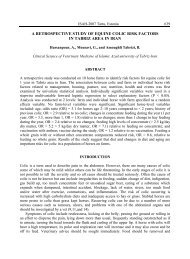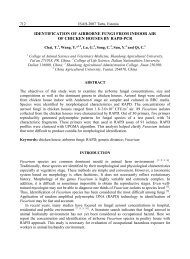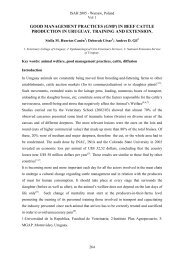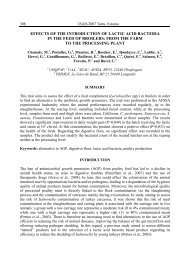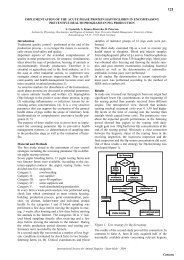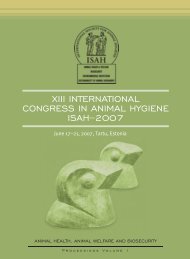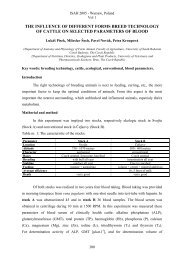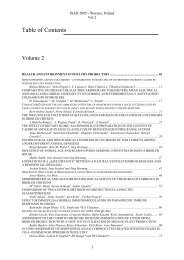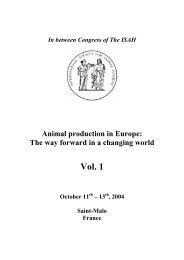monitoring environmental conditions during incubation ... - ISAH-SOC
monitoring environmental conditions during incubation ... - ISAH-SOC
monitoring environmental conditions during incubation ... - ISAH-SOC
Create successful ePaper yourself
Turn your PDF publications into a flip-book with our unique Google optimized e-Paper software.
MONITORING ENVIRONMENTAL CONDITIONS DURING INCUBATION OF<br />
CHICKEN EGGS<br />
Tong, Q. 1 , McGonnell, I.M 1 , Romanini, C. E.B. 2 , Exadaktylos, V. 2 , Berckmans, D. 2 , Bergoug, H. 3 , Guinebretière, M. 3 ,<br />
Eterradossi, N. 3 , Roulston, N. 4 , Garain, P. 4 , Demmers, T. 1<br />
1 Royal Veterinary College - Hertfordshire, UK<br />
2 Katholieke Universiteit Leuven - Leuven, Belgium<br />
3<br />
ANSES – Ploufragan, France<br />
4<br />
Petersime NV - Zulte (Olsene), Belgium<br />
SUMMARY<br />
Differences in <strong>environmental</strong> <strong>conditions</strong> <strong>during</strong> <strong>incubation</strong><br />
may alter hatching parameters and consequently affect<br />
chick quality and growth potential. The objective of this<br />
research was to study the effect of high CO 2 level <strong>during</strong><br />
late stages of <strong>incubation</strong>. Two small scale custom built<br />
incubators, each with a capacity of 300 eggs, (Petersime<br />
NV) were employed. The control group experienced a<br />
standard high CO 2 concentration program while the test<br />
group had a lower CO 2 program <strong>during</strong> the last 72 hours<br />
of <strong>incubation</strong>. Incubation <strong>conditions</strong> (air temperature, air<br />
humidity, CO 2 concentration and, ventilation rate) were<br />
controlled by the incubator controller (IRIS, Petersime TM .).<br />
Sensors were used to monitor eggshell temperature<br />
(OvoScan TM and Tsic 716 sensors), and hatching<br />
movement (Synchro-Hatch TM and camera). A standardised<br />
method (Petersime TM ) was used to score day-old chick<br />
quality.. Results showed that chickens commenced<br />
hatching 11 hours earlier in control group. However there<br />
was no difference in hatchability and hatching time<br />
between the two groups.<br />
INTRODUCTION<br />
Hormonal balance and CO 2 exchange are of fundamental<br />
importance for embryonic development <strong>during</strong> <strong>incubation</strong><br />
and may affect survival of the embryo [2, 8]. Previous<br />
studies have focused on the effect of high CO 2<br />
concentration <strong>during</strong> the early and second stages of<br />
<strong>incubation</strong> and suggest that higher levels of CO 2 can have<br />
beneficial and persistent effects on embryonic<br />
development <strong>during</strong> <strong>incubation</strong> by stimulating early<br />
hatching and improving hatchability [3, 4, 5, 7, 10].<br />
However, from biological and physiological point of view,<br />
it is not known how <strong>environmental</strong> CO 2 levels influence<br />
embryonic development and hatching. This study focused<br />
on explaining why high level of CO 2 concentration <strong>during</strong><br />
the hatcher phase (the last three days of <strong>incubation</strong>) can<br />
induce early piping and advanced hatching. Selected<br />
embryonic physiological parameters were compared<br />
between two treatments: standard <strong>incubation</strong> and low<br />
CO 2 -steady <strong>incubation</strong> in order to understand possible<br />
beneficial effects of high CO 2 concentration on hatching<br />
performance.<br />
MATERIAL AND METHODS<br />
588 fertilized Ross 308 eggs were obtained from a local<br />
supplier (Henry Stewart & Co. Ltd, Lincolnshire, UK). The<br />
eggs were weighed and numbered before setting. Eggs<br />
were incubated in two small scale custom built incubators<br />
(Petersime NV, Zulte, Belgium). Each incubator was able<br />
to set 300 eggs separately in 2 trays. Incubation<br />
<strong>conditions</strong> (machine temperature, humidity, CO 2<br />
concentration, and ventilation rate) were continuously<br />
monitored and controlled by the incubator controller<br />
(IRIS, Petersime TM ). CO 2 patterns of control group and<br />
test group were programmed and achieved by adjusting<br />
ventilation. The control group experienced the standard<br />
program with four phases of high CO 2 levels: reaching<br />
0.7% at <strong>incubation</strong> time 18day18hours (18:18),<br />
maintaining 1% 12 hours after onset of IP-step , and<br />
reaching 0.8% and 0.7% after 2hours and 6 hours of H<br />
(hatch) step initiation, respectively. In the test group CO 2<br />
concentration was maintained at 0.3%. Individual eggshell<br />
temperature (EST) of 10 eggs per incubator was<br />
measured every 5 minutes by temperature sensors<br />
(Tisc TM - 716, IST, Switzerland) <strong>during</strong> the entire<br />
<strong>incubation</strong> process. After transfer to hatcher baskets on<br />
day 18, the 10 eggs with temperature sensors were<br />
located in a designated area of the upper basket and the<br />
hatching process of the entire basket was monitored by<br />
camera (CCD digital colour camera, VDC 413) attached to<br />
the inside top of the incubator. Images were captureed<br />
every minute and saved automatically on a PC. All eggs<br />
were candled <strong>during</strong> transfer and those with evidence of a<br />
living embryo were transferred from the turning trays to<br />
hatching baskets. After 512h (21:08) of <strong>incubation</strong><br />
machines were stopped. The number and quality of<br />
hatched chicks were recorded and scored by a standard<br />
method (Petersime TM ). Hatchability was determined after<br />
hatch. The unhatched eggs were opened and checked.<br />
Data were expressed as means ± SE and differences<br />
between control and test groups at the same <strong>incubation</strong><br />
time were analysed using SAS 8.01. The variables of EST<br />
were analysed by an analysis of variance (ANOVA) using<br />
the GLM procedure (SAS Institute Inc., 1990), with ‘egg
categories’ as the main effects. A significance level of 0.05<br />
was used. Means were compared using Student-Newman-<br />
Keuls multiple range (SNK) test contrasts (SAS Institute<br />
Inc., 1990).<br />
RESULTS<br />
1. Hatching parameters<br />
Hatching parameters are summarized in Table 1.<br />
Hatchability was similar for both groups. When day-old<br />
chick quality scores were taken into account, the<br />
percentage of first class chick in control group was<br />
significantly higher than that in test group.<br />
Table 1. Fertility, hatchability and first class chick proportion<br />
Test Group<br />
Fertility 1 (%) 90.48 94.88<br />
Hatchability 2 (%) 74.18 75.19<br />
First Class Chick 3 (%) 86.19 98.97<br />
1<br />
Fertility expressed as percentage of eggs set.<br />
2<br />
Hatchability expressed as percentage of fertile eggs.<br />
3<br />
First Class Chick expressed as percentage of hatching chicks.<br />
control Group<br />
2. Eggshell temperature (EST)<br />
The status of the eggs with attached temperature sensors<br />
was determined after hatch. There were three categories<br />
of eggs: unfertilized (UN), dead embryos (D), and<br />
hatching chicks (H). The EST of 3 categories of eggs<br />
showed no significant difference <strong>during</strong> the first 11 days.<br />
However, egg status showed difference in EST at day 18,<br />
19 and 20 (Table 2). The EST of hatching eggs is higher<br />
than the EST of eggs with dead embryos and unfertilised<br />
eggs (P ≤ 0.05).<br />
Table 2. Eggshell temperature of three egg categories<br />
Incubation time(day) H-mean D-mean UN-mean<br />
18 37.3±0.12 a 36.6±0.12 b 36.43±0.15 b<br />
19 38.32±0.13 a 37.64±0.13 b 37.47±0.16 b<br />
20 37.7±0.12 a 37.09±0.12 b 36.97±0.15 b<br />
3. Hatching process<br />
The hatching time of first chick in the control group is at<br />
day 19 and 11 hours (19.11) compared to 19.22 in the<br />
test group (11 hours later (). Most chicks had hatched by<br />
20.17 in the control group compared to 21.06 in the test<br />
group. Thus the total length of hatching times (hatch<br />
window) for control and test groups are 30 hours and 32<br />
hours, respectively?<br />
Figure 3. Number of hatching chicks at different <strong>incubation</strong> time<br />
DISCUSSION<br />
Temperature sensors capture the EST <strong>during</strong> the complete<br />
<strong>incubation</strong> and show the division of EST of three egg<br />
statuses (unfertilised, dead and hatching). Due to an<br />
increased metabolism, piping action and hatching<br />
movement, the embryo increases heat production at the<br />
latter part of <strong>incubation</strong> which maintains the eggshell<br />
temperature <strong>during</strong> transfer, at day 19 and 20. Thus EST<br />
is significant lower in eggs housing dead embryos and
unfertilised eggs at this time. Hatching times within<br />
incubators vary greatly, with an average hatching window<br />
estimated between 32 and 48 hours [6, 9]. Cameras<br />
provided a tool to monitor the hatching process without<br />
opening the door of incubator. The end of hatch process is<br />
marked by the time when the majority of chickens have<br />
hatched and the incubator is stopped. It may also be that<br />
<strong>incubation</strong> management, with regards to ending the<br />
<strong>incubation</strong> at the appropriate time, may optimize<br />
hatchability and chick quality. Previous research has<br />
reported that an earlier hatch does not result in a smaller<br />
duration of the hatching process[1].In this study, the<br />
hatching window of control group is only slightly shorter<br />
than the test group, even though the hatch started 11<br />
hours early.<br />
CONCLUSIONS<br />
Corticosterone levels increased significantly at the end of<br />
<strong>incubation</strong> and can stimulate the hatch process. High CO 2<br />
level of <strong>incubation</strong> condition can stimulate corticosterone<br />
and this may explain why the chicks in the control group<br />
hatched early and have higher quality compared with the<br />
test group. Further research is needed into the impact of<br />
CO 2 concentrations on hormones levels and hatching<br />
windows.<br />
REFERENCES<br />
1. BAMELIS, F., B. KEMPS, K. MERTENS, B. DE KETELAERE, E. DECUYPERE, AND J. DEBAERDEMAEKER. (2005). An automatic <strong>monitoring</strong> of<br />
the hatching process based on the noise of the hatching chicks. Poult Sci 84:1101-1107.<br />
2. BLACKER, H. A., S. ORGEIG, AND C. B. DANIELS. (2004). Hypoxic control of the development of the surfactant system in the chicken: evidence<br />
for physiological heterokairy. Am J Physiol Regul Integr Comp Physiol 287:R403-410.<br />
3. DE SMIT, L., V. BRUGGEMAN, M. DEBONNE, J. K. TONA, B. KAMERS, N. EVERAERT, A. WITTERS, O. ONAGBESAN, L. ARCKENS, J. DE<br />
BAERDEMAEKER, AND E. DECUYPERE. (2008). The effect of nonventilation <strong>during</strong> early <strong>incubation</strong> on the embryonic development of chicks of<br />
two commercial broiler strains differing in ascites susceptibility. Poult Sci 87:551-560.<br />
4. DE SMIT, L., V. BRUGGEMAN, J. K. TONA, M. DEBONNE, O. ONAGBESAN, L. ARCKENS, J. DE BAERDEMAEKER, AND E. DECUYPERE.<br />
(2006). Embryonic developmental plasticity of the chick: increased CO(2) <strong>during</strong> early stages of <strong>incubation</strong> changes the developmental trajectories<br />
<strong>during</strong> prenatal and postnatal growth. Comp Biochem Physiol A Mol Integr Physiol 145:166-175.<br />
5. EVERAERT, N., M. DEBONNE, H. WILLEMSEN, A. WITTERS, B. KAMERS, J. DE BAERDEMAEKER, E. DECUYPERE, AND V. BRUGGEMAN.<br />
(2010). Interaction between ascites susceptibility and CO <strong>during</strong> the second half of <strong>incubation</strong> of two broiler lines. Effect on embryonic development<br />
and hatching process. Br Poult Sci 51:335-343.<br />
6. TONA, K., F. BAMELIS, B. DE KETELAERE, V. BRUGGEMAN, V. M. MORAES, J. BUYSE, O. ONAGBESAN, AND E. DECUYPERE. (2003).<br />
Effects of egg storage time on spread of hatch, chick quality, and chick juvenile growth. Poult Sci 82:736-741.<br />
7. TONA, K., O. ONAGBESAN, V. BRUGGEMAN, L. DE SMIT, D. FIGUEIREDO, AND E. DECUYPERE. (2007). Non-ventilation <strong>during</strong> early<br />
<strong>incubation</strong> in combination with dexamethasone administration <strong>during</strong> late <strong>incubation</strong>: 1. Effects on physiological hormone levels, <strong>incubation</strong> duration<br />
and hatching events. Domest Anim Endocrinol 33:32-46.<br />
8. TULLETT, S. G. (1990). Science and the art of <strong>incubation</strong>. Poult Sci 69:1-15.<br />
9. VAN DE VEN, L. J. F., A. V. VAN WAGENBERG, P. W. G. G. KOERKAMP, B. KEMP, AND H. VAN DEN BRAND. (2009). Effects of a combined<br />
hatching and brooding system on hatchability, chick weight, and mortality in broilers. Poultry Science 88:2273-2279.<br />
10. WILLEMSEN, H., K. TONA, V. BRUGGEMAN, O. ONAGBESAN, AND E. DECUYPERE. (2008). Effects of high CO 2 level <strong>during</strong> early <strong>incubation</strong><br />
and late <strong>incubation</strong> in ovo dexamethasone injection on perinatal embryonic parameters and post-hatch growth of broilers. Br Poult Sci 49:222-231.



